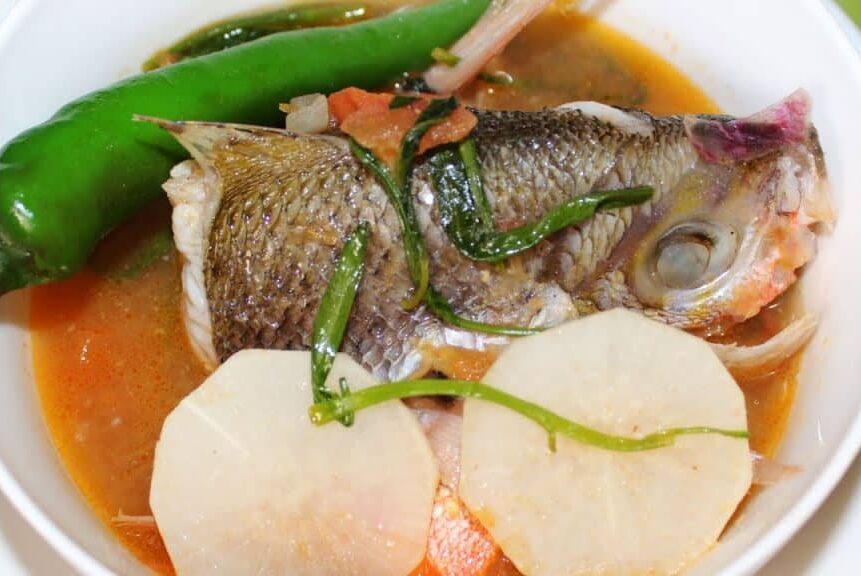Here’s a simple recipe for Salmon Sinigang, a Filipino sour soup:
Ingredients:
- 1 lb salmon fillet, cut into serving portions
- 1 large onion, quartered
- 2 medium-sized tomatoes, quartered
- 1 eggplant, sliced
- 1 radish, peeled and sliced
- 1 bunch string beans, cut into 2-inch pieces
- 1 medium-sized daikon (white radish), peeled and sliced
- 1 packet sinigang tamarind soup mix
- 2-3 green chili peppers (siling haba)
- 1.5 liters water
- Fish sauce (patis) or salt to taste
- Freshly ground black pepper to taste
- Bok choy or kangkong (water spinach) for added greens (optional)
Instructions:
- In a large pot, bring the water to a boil.
- Add the salmon fillet, onions, and tomatoes. Simmer for about 5-7 minutes until the salmon is partially cooked.
- Stir in the sinigang tamarind soup mix and add the daikon (white radish) and radish. Let it simmer for another 5 minutes.
- Add the eggplant, string beans, and green chili peppers. Continue simmering until the vegetables are tender.
- Season the sinigang with fish sauce or salt to taste. Adjust the sourness by adding more sinigang mix if needed.
- Add freshly ground black pepper to taste.
- If using bok choy or kangkong, add it to the pot and cook until just wilted.
- Taste and adjust the seasoning if necessary.
- Serve hot with steamed rice.
Enjoy your Salmon Sinigang!
FAQs
-
What does sinigang consist of?
- Sinigang is a Filipino sour soup characterized by its tangy and savory flavor. It typically consists of a tamarind-based broth, various vegetables like radish, eggplant, string beans, and leafy greens. Meats such as pork, shrimp, or in this case, salmon, are commonly used to enhance the soup’s taste. The dish is seasoned with fish sauce or salt and may include additional flavorings like green chili peppers.
-
How do I make my sinigang more sour?
- To make sinigang more sour, you can adjust the quantity of sinigang tamarind soup mix added to the broth. Increase the amount of tamarind mix until you achieve the desired level of sourness. Alternatively, you can add fresh tamarind or tamarind concentrate for a more pronounced tang. Keep in mind that personal preferences for sourness may vary, so it’s best to adjust the ingredients to suit your taste.
-
Is sinigang healthy or not?
- Sinigang can be a healthy dish, especially when prepared with an abundance of fresh vegetables and lean proteins like fish or shrimp. Vegetables provide essential vitamins and minerals, while the broth offers a low-calorie and hydrating base. However, the overall healthiness depends on the ingredients used and portion sizes. If using lean proteins and moderating the use of fats and sodium, sinigang can be a nutritious and balanced meal.
-
Why is sinigang so good?
- Sinigang’s popularity lies in its harmonious blend of flavors, combining the savory taste of the broth with the tanginess from tamarind or other souring agents. The diverse assortment of vegetables and the choice of meats contribute to a well-rounded and satisfying dish. The comforting warmth of sinigang, coupled with its ability to be customized based on personal preferences, makes it a beloved Filipino comfort food. The familiarity of its taste and the nostalgic connection to Filipino culinary traditions also contribute to its widespread appeal.

Pages: 1 2
